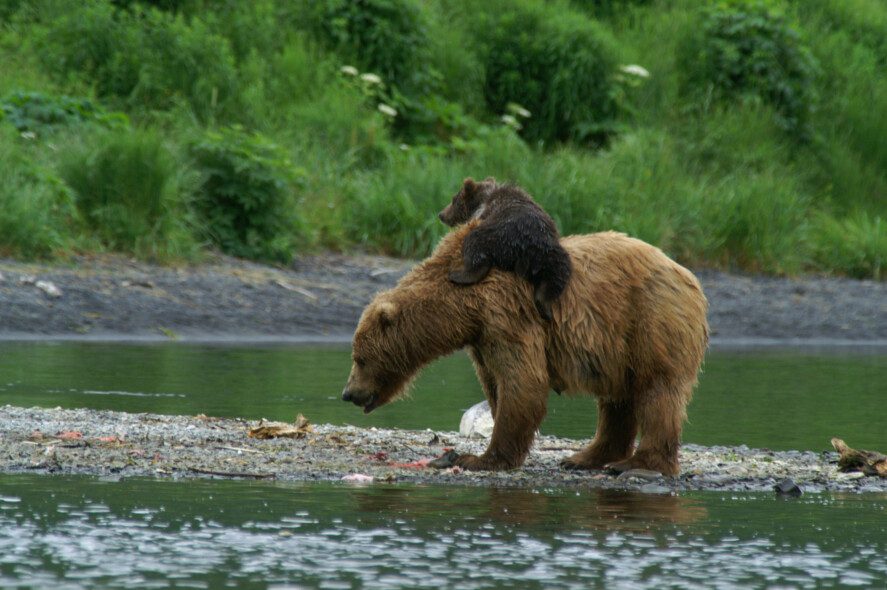One of Alaska’s largest and fascinating land animals is the grizzly bear.
Without a doubt they are also one of the state’s most-popular must-see attractions. When a creature this big, burly and beastly thrives in a place as harsh and unforgiving as Alaska’s toughest wilderness landscapes, they are bound to have a few scary legends swirling about them. Heck, even their name – “grizzly” bear – invokes fear and folklore. As with most legends, however, there’s a level of mythology mixed in with the truths surrounding grizzlies.

Peek-a-boo grizzly bear at Kodiak Brown Bear Center
Here are five myths and truths about Alaska’s grizzly bear, it’s most massive, majestic and mysterious mammal:
Myth #1: Alaska’s grizzly bears are practically impossible to see in the wild.
Yes, grizzly bears are elusive, private and typically traverse the gnarliest of Alaska’s wilderness landscapes. Even the most well-traveled Alaskan outdoors enthusiasts aren’t likely to encounter a grizzly bear in their adventures … and if they do, hopefully from a great distance. But big-time bear enthusiasts and grizzly groupies can increase their odds of seeing them in the wild by visiting the hot spots they frequent as they emerge from their winter habitats and by trusting experienced bear viewing tour guides and tour operators. Some people hit the jackpot with grizzly sightings when traveling in Denali National Park, but that can be a semi-rare occurrence as you are constantly moving through the park by one road and the Park’s territory and overall size is enormous, giving the grizzlies plenty of room for evasion. There are practically guaranteed sightings of grizzlies however, in the bear’s natural habitat just an hour-or-so flight out of Alaska’s largest city, Anchorage. Tour operators lead visitors through bear-busy bruin areas of Katmai National Park and Kodiak Island, Lake Clark National Park (on the Kenai Peninsula), Admiralty Island and Tongass National Forest (Anan Creek in Southeast Alaska). Bear viewing guides get their clients camera-and-salmon-crunching close while also keeping them at a safe distance from the stars of the show: those glamourous grizzlies just doing what grizzlies do, free in their natural habitat.

Sibling bear cubs learning together.
Myth #2: Grizzlies are carnivorous.
While grizzly bears are at the top of the wildlife food chain in Alaska, their diets are more akin all-inclusive buffets vs meat-eating orgies. Grizzlies love fish, of course – salmon are a staple of their fine dining, as well as an excellent source of protein and fats. But grizzly bears also enjoy filling themselves up with nutrient-heavy grasses, plants and berries. And since grizzlies, like most bears, are constantly feeding to fatten themselves up for a happy hibernation, they aren’t all that picky. If it’s edible and they can get to it, they’ll probably eat it. Eggs in nests. Berries in bushes. Small rodents. Big game. And while they do eat as much meat as they can – caribou or moose are big meals – they do not hunt or have a hunger for humans. But do just stick to the bear necessities: keep your distance and don’t bring food near them, much less attempt to feed them.

Grizzly bears can be competitive with each other over food.
Myth #3: Grizzlies and brown bears are two different species.
Alaska’s Department of Fish and Game notes that “brown and grizzly bears are classified as the same species even though there are notable differences between them.” Their major differences are in terms of girth and geography. “Grizzlies” are typically slightly smaller than brown bears and live and travel in mostly inland areas, in the Interior and Northern regions of Alaska, while “brown bears” are larger, perhaps due to their diet which is rich in salmon and other fish and they tend to live in Alaska’s coastal areas.
Myth #4: Grizzlies are, like, scary, ridiculously big, right?

Alaska brown bear checking out the scenery.
If you believe this one, you’ve probably watched too many bear movies or documentaries, which certainly use bigger bears for equally big scares (and an occasional big laugh). Those would be well-fed Hollywood bears and the world-famous Kodiak brown bears, the largest subspecies of the brown bear and grizzly clan who can tip the scales at up to 1,500 pounds. Most full-grown mainland Alaska grizzly bears, however, tend to weigh between 300-800 pounds, are around 6 feet in length nose to tail and with shoulders that rise slightly above the 3-foot mark. So yeah, that’s still pretty darn big, but maybe not movie-monster big.
Myth #5: Because grizzly bears are so heavy, they’re slow.
This is one myth you don’t want to test. Those big, brawny lunks of seemingly lumbering fur are actually freakishly fast. Like 25-30 MPH fast. And nothing gets them moving faster or quicker than something getting between them and their cubs or their food. So be aware and smart when you are traveling in areas that are populated by bears.

Mamma bear carrying cub while looking for food.
If you’re hooked on grizzlies and want to experience these magnificent creatures first-hand up in Alaska, take a look at our bear viewing tours to get a flavor for what you can look forward to.
